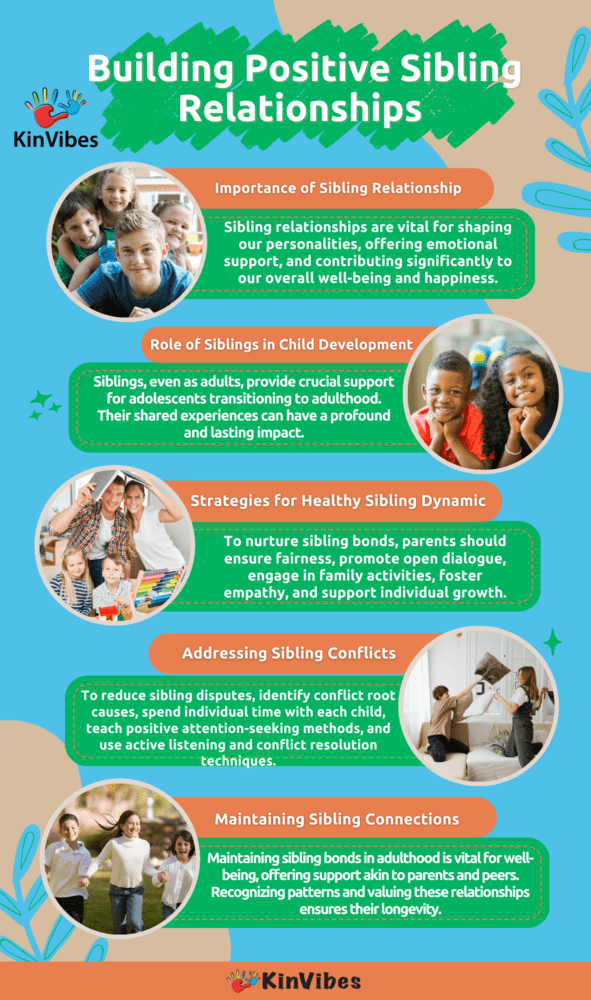Sibling relationships hold a unique and powerful place in our lives, shaping our personalities, providing emotional support, and forming lifelong connections. While often overlooked, these relationships are crucial to our well-being and happiness.
In this article, we will understand the importance of positive sibling relationships, explore strategies for fostering healthy dynamics, and examine the challenges that may arise in other family relationships.
By understanding the impact of sibling relationships on child development and learning how to navigate conflicts and life transitions, we can create more robust, supportive bonds among siblings. Let’s embark on this journey together and discover the actual value of these essential connections.
Key Takeaways
- Sibling relationships are integral to the family unit and significantly impact child development.
- Parents can foster healthy sibling dynamics by engaging in family activities, avoiding favoritism, encouraging communication, promoting empathy, and providing growth opportunities.
- Maintaining connections with siblings throughout life is essential for long-term well-being. Successful case studies illustrate how strong supportive connections promote overall well-being.

The Importance of Positive Sibling Relationships

Siblings are invaluable; they offer irreplaceable emotional support, companionship, and build enduring connections. The dynamics of sibling relationships, including younger siblings, are impacted by a variety of factors, including:
- Intrapsychic processes such as attachment and social comparison
- Relational dynamics, including social learning
- More distant influences like sociocultural forces.
Parents play a pivotal role in strengthening the sibling bond by providing opportunities for enjoyable experiences and equipping them with the necessary skills to resolve conflicts. Acclimating to life changes and preserving sibling relationship qualities throughout life can be challenging.
However, by understanding the importance of sibling relationships and the factors that influence them, we can work to build stronger, more supportive bonds among family members.
The Role of Siblings in Child Development
According to the Journal of Family Psychology, sibling influences play a significant role in child development, acting as important teachers and models for behavior that can positively affect future outcomes.
Siblings can impact risky behaviors during adolescence, and sibling relationship quality plays a crucial role in this influence.
Siblings, including adult siblings, serve as a support system for adolescents who are transitioning to adulthood and independence. Shared experiences between siblings, such as older siblings and younger siblings, can be incredibly powerful and have a lasting impact.
Appreciating siblings’ pivotal role in child development and promoting positive interactions help lay strong foundations for children’s future success and happiness.
Emotional Support and Lifelong Bonds
In adulthood, siblings provide companionship and emotional support, contributing to healthy family relationships. Strong sibling relationships offer emotional support and stability to family systems, thus having a positive effect on overall well-being and family life. Emotional support and stability are of utmost importance for fostering strong adult sibling relationships, as they offer a sense of security and comfort that can endure for a lifetime.
Fostering robust sibling relationships guarantees continued emotional support and stability throughout life, enhancing overall well-being and happiness.
Strategies for Fostering Healthy Sibling Dynamics
| Strategy | Description |
|---|---|
| Being mindful of treatment | Treat each child fairly and avoid making comparisons between siblings to lessen rivalry. |
| Encouraging open communication | Promote open dialogue and ensure conflicts are resolved peacefully. |
| Promoting shared activities and experiences | Engage in activities as a family to strengthen bonds and reduce conflicts between siblings. |
| Fostering empathy and understanding | Educate children on the importance of recognizing differences and discovering shared interests. |
| Providing opportunities for growth | Allow each child to have their own experiences and independence to foster individual growth. |
| Encouraging Empathy And Understanding | Instruct siblings to value each other’s distinctions and cultivate listening skills. |
| Promoting Cooperation And Teamwork | Encourage siblings to work together on chores or tasks, promoting collaboration and teamwork. |
Engaging in activities as a family can be beneficial for these relationships and reduce conflicts between them.
As a parent, there are several steps one can take to cultivate the ties between their children, which one can hope will be enduring. Some strategies to consider include:
- Being mindful of how parents treat each child and avoiding favoritism
- Encouraging open communication and resolving conflicts peacefully
- Promoting shared activities and experiences
- Fostering a sense of empathy and understanding
- Providing opportunities for individual growth and independence
Implementing these strategies aids in child development perspectives and creates a nurturing environment conducive to siblings forming durable and robust relationships.
Encouraging Empathy and Understanding
Instructing siblings to value each other’s distinctions and cultivate listening aptitudes to enhance empathy and comprehension is crucial for a healthy family system.
To promote this, you can:
- Educate children on the importance of recognizing dissimilarities and discovering shared interests
- Encourage open communication and active listening between siblings
- Foster a supportive and inclusive environment where each sibling feels valued and respected
These practices can contribute to the development of strong intimate relationships between siblings.
Instructing children to disagree respectfully is of great importance as it assists them in managing disagreements in an advantageous manner and sustaining amiable interactions. Promoting empathy and understanding among siblings fosters a more harmonious and supportive family environment.
Promoting Cooperation and Teamwork
Having siblings cooperate on chores can be advantageous to their relationship by stimulating them to collaborate toward a shared objective. Siblings can undertake tasks such as sweeping or assisting in the preparation of dinner together. Promoting sibling teamwork can be achieved through assigning shared chores, projects, and activities that necessitate collaboration.
Encouraging cooperation and teamwork among siblings can lead to stronger sibling bonds, and improved sibling dynamics.
While sibling relationships play a pivotal role in a child’s development, the overarching parenting style adopted by parents can significantly mold their upbringing. For a comprehensive insight into how various parenting approaches can influence a child’s growth, check out our detailed piece on Parenting Styles and Their Impact on Child Development.
Navigating Sibling Conflicts

Attending to the root causes of sibling conflicts is essential to reduce sibling quarrels. Here are some strategies to consider:
- Implement one-on-one time with each child to give them individual attention and reduce competition for attention.
- Assist your child in finding more constructive, non-confrontational ways to gain their sibling’s attention.
- Practice active listening, problem-solving, and compromise as techniques for resolving conflicts.
By addressing the underlying issues of sibling bullying and teaching your children effective conflict resolution skills, you can help decrease sibling disputes.
Addressing the underlying causes of sibling conflicts and applying conflict resolution techniques can preserve healthy sibling relationships and lower familial tensions, ultimately reducing sibling conflict.
Identifying the Root Causes
Attention-seeking behavior, sibling jealousy, competition, and power struggles are some of the underlying causes of sibling conflicts. To address the root causes of sibling conflicts effectively, it is important to provide emotional support, encourage empathy and understanding, and promote cooperation and teamwork.
For instance, parents can demonstrate advantageous familial interactions, abstain from favoritism and comparison, and supply emotional support to their offspring. They can also stimulate empathy and comprehension and encourage collaboration and teamwork among siblings. Understanding and tackling the root causes of sibling conflicts can lead to a more harmonious family environment.
Conflict Resolution Techniques
The imparting of conflict resolution techniques to children enables them to comprehend how to disagree respectfully, communicate proficiently, and settle conflicts without turning to physical aggression. Parents can encourage their children to listen to one another, esteem each other’s perspectives, and be open to compromise.
Active listening, employing “I” statements, and abstaining from blaming language are some techniques effective in communication. Conflicts may be resolved without physical aggression by employing problem-solving skills, such as brainstorming solutions and negotiating.
Equipping siblings with effective conflict resolution techniques can aid in maintaining healthy relationships and reducing familial tensions.
The Role of Parents in Shaping Sibling Relationships

Parents play a significant role in shaping sibling relationships by avoiding favoritism comparisons and modeling positive family interactions. It has been observed that the perception of not being favored is associated with a lack of adaptation and has a detrimental effect on the quality of relationships with parents and siblings.
Parents can encourage their children to develop such a close bond between siblings by:
- Emphasizing the importance of healthy relationships with other friends and family members
- Recognizing their influence on sibling relationships
- Taking action towards nurturing strong bonds among their children
Avoiding Favoritism and Comparison
It is essential to treat siblings age and each child fairly and to abstain from making comparisons between siblings to lessen sibling rivalry and foster healthy relationships. To prevent favoritism between siblings, the following strategies may be utilized:
- Refrain from comparing your children to one another.
- Abstain from setting them up for competition.
- Refrain from acting as a judge in their disputes.
- Recognize and appreciate each child’s unique qualities and strengths.
- Stimulate healthy sibling relationships by promoting cooperation and teamwork.
Avoidance of favoritism and comparison can help parents to foster a supportive and nurturing environment, contributing to the development of strong and healthy sibling and peer relationships throughout.
Modeling Positive Family Interactions
Modeling positive family interactions entails exhibiting healthy communication, respect, and problem-solving skills within the family to set a positive example for siblings. To demonstrate positive family interactions to young siblings, parents should strive to:
- Understand their children’s point of view
- Initiate and maintain positive interactions
- Communicate effectively
- Show respect and care
- Allocate quality time
- Set boundaries and rules
- Actively listen and empathize
- Express love and appreciation
- Be present and attentive
- Cultivate teamwork and mutual appreciation within the family.
Demonstrating positive family interactions sets a powerful example for children and contributes to a supportive environment that nurtures healthy sibling relationships.
Sibling Relationship Challenges Throughout Life
Sibling relationships may face challenges during life transitions, but maintaining connections in adulthood is essential for long-term well-being. The Harvard Study of Adult Development demonstrated that individuals who reported a substandard relationship with siblings or at least one sibling at the age of 18 or 19 had a higher probability of experiencing major depression and utilizing mood-altering drugs by the age of 50.
Sibling relationships remain significant in adulthood. When pursuing individual goals, the support from siblings can be as valuable as that from parents and peers.
Sibling relationships remain significant in adulthood. When pursuing individual goals, the support from siblings can be as valuable as that from parents and peers.
Recognizing the potential challenges of sibling relationships throughout life allows us to preserve these vital connections and enhance long-term well-being.
Adjusting to Life Transitions
Recognizing that modification is an unavoidable element of life is of great importance as it assists us in becoming more resilient and better prepared for life transitions. Identifying and expressing one’s feelings can be accomplished by taking the time to reflect upon one’s emotions and to consider what one is feeling. Once the feelings have been identified, it is essential to express them in a healthy manner.
Developing a routine to establish stability may involve:
- Setting a regular sleep schedule
- Eating healthy meals
- Engaging in physical activity
- Taking time for yourself
Having a routine can be beneficial in providing structure and stability during life transitions, helping to maintain healthy sibling relationships throughout life’s changes.
Maintaining Connections in Adulthood

Sustaining connections in adulthood with sibling relations is imperative for enduring mental health. It is not uncommon for siblings to revert to the traditional roles of their family and experience frustration due to patterns that frequently recur, such as an older sibling feeling that a younger sibling does not contribute as much as they should and a younger sibling feeling discontent with unsolicited advice from an older sibling.
Patients can strive to acknowledge the role they play in existing patterns and contemplate their siblings’ behavior from an alternative perspective in order to reset the dynamic within their sibling relationships. Appreciating the significance of preserving close sibling relationships in adulthood and striving to overcome challenges helps sustain these supportive and stable connections throughout life.
Case Studies: Successful Sibling Relationships
Numerous accounts of siblings have weathered difficulties and sustained robust, encouraging relationships throughout their lives. These successful sibling pairs and relationships often inspire and testify to the power of overcoming challenges and maintaining strong bonds.
Adler’s theory of individual developmental psychology and Bowlby’s attachment theory, for example, both emphasize the importance of healthy sibling relationships in shaping an individual’s unique style of life and overall well-being.
Studying real-life examples of successful sibling relationships provides valuable insights into the strategies and techniques that bolster strong, supportive connections throughout life.
Frequently Asked Questions
What is a typical sibling relationship?
Siblings often share a unique relationship that is characterized by common experiences, understanding, and support. Growing up together gives them an understanding of one another and the knowledge to be companions as well as influencers in each other’s lives.
What are the different types of sibling relationships?
Intimate, Congenial and Loyal are the most common types of adult sibling relationships, representing the majority of familial dynamics. Traditional siblings are brothers and sisters with the same mother and father, while Half siblings share either the same mother or the same father. Stepsiblings are brothers and sisters who are not related to one child biologically, but whose parents are married to each other.
What are the roles in sibling relationships?
Siblings act as sources of support, companionship, and role models in early and middle childhood, while providing a similar peer relationship based on equality, reciprocity, and sharing. Additionally, sibling relationships are also often characterized by conflict and competition.
What are the three important characteristics of sibling relationships?
Judy Dunn, one of the most prominent researchers of sibling relationships, identifies emotional quality, familiarity and intimacy, and conflict as the three most important characteristics of sibling relationships.
Why are some siblings not close?
Siblings may not be close due to circumstances like different upbringings, maintaining a healthy emotional distance, or trauma experiences. These situations can create a disconnect between siblings, leading to a strained relationship.
Wrapping Up
Sibling relationships are important in our lives, providing emotional support, companionship, and lifelong connections. Understanding the factors that influence sibling relationships, implementing strategies to foster healthy dynamics, and addressing challenges that may arise throughout life can create stronger, more supportive bonds among siblings.
As we navigate the complexities of life, let’s remember the invaluable connections we share with our siblings and strive to maintain and nurture these relationships for the benefit of our well-being and happiness.
As we delve deeper into sibling dynamics, we should understand how the sequence of birth can shape an individual’s personality and growth. Explore more on this fascinating topic in our article From Firstborn to Last: How Birth Position Impacts Development.





